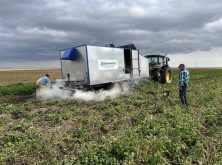A herbicide with a novel active ingredient could soon become available for Prairie farmers struggling with kochia and other weeds.
Last summer, Sumitomo Chemical registered its novel herbicide in Argentina, and the Japanese company has global ambitions for the product, known as Rapidicil.
“Sumitomo Chemical aims to achieve annual revenue of 100 billion yen (about Cdn$958 million) from the sale of herbicides for no-till farming, including Rapidicil,” a company news release said last July.
In North America, Valent has acquired the rights to market and distribute the herbicide. It’s not yet available to farmers as it grinds its way through the registration system in Canada and the United States.
Read Also

Claas brings 1000 Series SP forage harvesters to Canada
In mid-August, Claas unveiled its new line of Jaguar forage harvesters at an event in Visalia, California, deep in the heart of that state’s dairy region.
“We anticipate it will be registered in February of 2026 (in the U.S.),” Pat Clay, product development manager for Valent USA, said at the Commodity Classic in Denver in March.
In Canada, registration may take a “little bit” longer, Clay added.
“You never can predict, exactly. I would say months to a year, at most, is my best guess.”
The novel herbicide falls into Group 14 — the protoporphyrinogen oxidase, or PPO, inhibitors — but its chemistry is slightly different than other PPO inhibitors. Company testing shows the non-selective herbicide is effective against both grassy and broadleaf weeds.
“This material has higher grass activity than other PPOs currently on the market,” Clay says.
“So, Rapidicil is going to be pre-plant burndown. It’s going to be a really nice fit in no-till, reduced till production systems… It is highly mobile in the plant. It is truly systemic. It’s not just a contact herbicide.”
Rapidicil is the brand name for the active ingredient in the herbicide. When it comes to market, it will be sold under a different brand, Clay says.
The herbicide could be needed sooner than later because many growers in Saskatchewan and Alberta are struggling with herbicide-resistant kochia. Research shows kochia populations have developed resistance to Group 9 (glyphosate), Group 2, Group 14 (PPOs) and Group 4 herbicides.
Kochia on the Prairies probably isn’t resistant to all four groups of herbicides but could be resistant to some combination of Groups 9, 2, 14 and 4.
Valent testing, done last year in Kansas, suggests Rapidicil is effective on kochia.
When applied alone, it provided more than 90 per cent control of kochia 14 days after treatment.
However, Valent wants to preserve the efficacy of Rapidicil. Farmers can only use it in combination with another herbicide.
“The label, once it is approved, will require tank mixing with another mode of action — period,” Clay said.
“That can be glyphosate, glufosinate, 2,4-D, dicamba (or others).”
Sumitomo Chemical hopes to sell a large volume of Rapidicil for weed burndown in North and South America. It also has a partnership with Bayer, which could further boost sales, the company says.
“Sumitomo Chemical will continue to work to provide agricultural producers with a next-generation weed control system combined with the PPO-inhibitor tolerant crops currently being developed by Bayer.”
















